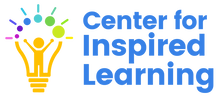Many of the school reforms we've come across use the "superhero model" of teaching. We've probably all seen inspiring segments on the evening news, shared on social media, or on an Oprah segment about a one-of-a-kind super-energized, hyper-successful teacher. We absolutely love that such teachers exist, but we don't feel that it's healthy, necessary, or even remotely possible to fill every classroom with super-teachers who seemingly have endless amounts of time, energy, enthusiasm, and sometimes access to extra financial resources. Instead, we want to create school environments where any trained teacher can facilitate kids to become super students through their own organic learning process.
The standard classroom of today, as it has for well over a century, consists of a teacher standing in front of a classroom of kids, imparting specific knowledge, training the kids to be good test-takers, and each student following the exact same learning path. The students are inevitably at different levels as far as knowledge, maturity, self-discipline, and socioeconomic background. Teachers are expected to prepare each lesson, lead it, then find some way to evaluate every student in an unbiased way. To succeed, they also have to be classroom managers, disciplinarians, and bureaucrats. On top of all this, teachers have to be motivational speakers, figuring out ways to "get" kids to do things they would really rather not be doing.
|
The Inspired Learner Model (ILM) meets the students where their passions already are and guides them through the educational process by putting each one on an individual personal student growth program, and then using things like online curricula, peer-based mentoring, community engagement, and project-based learning to achieve educational goals. This type of education requires a lot less prep time from the teacher, yet students end up with far more learning opportunities and potential.
|
Gone is the need to figure out a way to coerce every kid to do a task they would rather not be doing. Instead, the teacher's job is to ignite a student's curiosity, becoming what we like to call a "life-learning facilitator."
The Inspired Learner Model radically changes the superhuman expectations schools tend put on teachers. Like all of us, teachers are far more effective when they feel loved, appreciated, enthusiastic, and fulfilled by their job. This will allow teachers to build relationships with the kids and the community beyond. Teachers will get to see the "light come on" within the kids. Teachers will feel supported and reinvigorated.
This may seem difficult to believe, or pie-in-the-sky, but student-centered models like the we are proposing have been successfully implemented in schools in the United States and beyond, with teachers having far higher job satisfaction and less stress.
KEY TERMS
Whole Classroom Instructional Model (WCIM) - The century-old structure of sorting children by age, randomly placing them in groups of 20 to 30, then teaching them the SAME material, at the SAME time, at the SAME pace, in the SAME way, by the SAME teacher. Children are seen as passive recipients of information and knowledge and rarely, if ever, take ownership of their learning. Students move between classrooms during the day, move “up” through grade levels over the years, and eventually leave school for the workforce, likely to never step foot again in the place where they spent so much of their childhood. Assessments in this rigid system are done primarily via test-taking. The teacher is at the center of the learning process.
Synonyms:
Learner-Centered Model (LCM) - The impetus for learning comes from a child's innate curiosity. This structure gives students control over the content of lessons and the learning method and promotes autonomy and active learning. The learner is at the center of the learning process. The teacher is seen as a facilitator of the learning process rather than "the sage on the stage."
Synonyms:
Inspired Learner Model (ILM) - A learner-centered education model developed by the Center for Inspired Learning that is designed to work in US public elementary schools using existing school infrastructure, budgets, and staffing. Its components include project and activity-based learning (PABL), peer mentoring, enhanced learning through technology, student choice, parental involvement, community engagement, and other mechanisms to support and encourage children to become lifelong curious learners. Besides traditional elementary school curriculum, ILM may include an emphasis on self-care, financial literacy, media and digital literacy, communication skills, conflict resolution, global citizenship, the arts, and learning at least one foreign language.
Synonyms:
- Standardized Education
- Teacher-Centered Learning
- One-Size-Fits-All Instructional Model
- Factory (Assembly Line) Education Model
- Taylorist Model
- Coercive Schooling
Learner-Centered Model (LCM) - The impetus for learning comes from a child's innate curiosity. This structure gives students control over the content of lessons and the learning method and promotes autonomy and active learning. The learner is at the center of the learning process. The teacher is seen as a facilitator of the learning process rather than "the sage on the stage."
Synonyms:
- Individualized Learning
- Student-Centered Learning
- Adaptive Learning
- Blended Learning
- Personalized Learning
- Competency-Based Education
Inspired Learner Model (ILM) - A learner-centered education model developed by the Center for Inspired Learning that is designed to work in US public elementary schools using existing school infrastructure, budgets, and staffing. Its components include project and activity-based learning (PABL), peer mentoring, enhanced learning through technology, student choice, parental involvement, community engagement, and other mechanisms to support and encourage children to become lifelong curious learners. Besides traditional elementary school curriculum, ILM may include an emphasis on self-care, financial literacy, media and digital literacy, communication skills, conflict resolution, global citizenship, the arts, and learning at least one foreign language.
A 501(c)(3) Nonprofit - EIN 82-4387189




